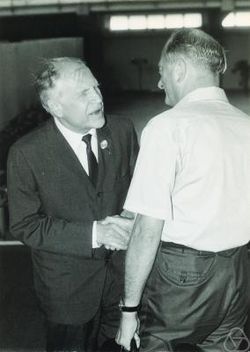Lev Pontryagin
| Lev Pontryagin | |
|---|---|

Lev Semenovich Pontryagin (left)
|
|
| Born |
3 September 1908 Moscow, Russian Empire |
| Died | 3 May 1988 (aged 79) Moscow, Soviet Union |
| Nationality | Soviet Union |
| Fields | Mathematics |
| Doctoral advisor | Pavel Alexandrov |
| Doctoral students |
Dmitri Anosov Vladimir Boltyansky Revaz Gamkrelidze Evgenii Mischenko Mikhail Postnikov Mikhail Zelikin |
| Known for |
Pontryagin duality Pontryagin class Pontryagin cohomology operation Pontryagin's minimum principle Bang–bang control Andronov–Pontryagin criterion |
Lev Semyonovich Pontryagin (Russian: Лев Семёнович Понтрягин, also written Pontriagin or Pontrjagin) (3 September 1908 – 3 May 1988) was a Soviet mathematician. He was born in Moscow and lost his eyesight due to a primus stove explosion when he was 14. Despite his blindness he was able to become one of the greatest mathematicians of the 20th century, partially with the help of his mother Tatyana Andreevna who read mathematical books and papers (notably those of Heinz Hopf, J. H. C. Whitehead, and Hassler Whitney) to him. He made major discoveries in a number of fields of mathematics, including algebraic topology and differential topology.
Pontryagin worked on duality theory for homology while still a student. He went on to lay foundations for the abstract theory of the Fourier transform, now called Pontryagin duality. With René Thom, he is regarded as one of the co-founders of cobordism theory, and co-discoverers of the central idea of this theory, that framed cobordism and stable homotopy are equivalent. This led to the introduction around 1940 of a theory of certain characteristic classes, now called Pontryagin classes, designed to vanish on a manifold that is a boundary. In 1942 he introduced the cohomology operations now called Pontryagin squares. Moreover, in operator theory there are specific instances of Krein spaces called Pontryagin spaces.
...
Wikipedia
